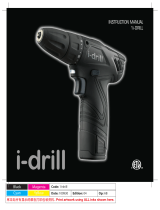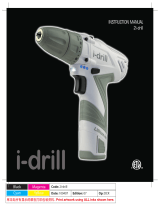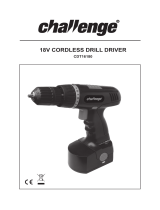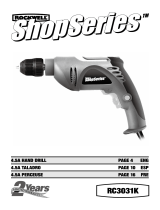Rockwell RK2510K2 User manual
- Category
- Cordless combi drills
- Type
- User manual
This manual is also suitable for

12 V CORDLESS DRILL/DRIVER PAGE 4 ENG
12 V OLTIOS TALADRO INALAMBRICO PAGE 11 ESP
PERCEUSE/TOURNEVIS À 12 V PAGE 19 FRE
RK2510/RK2510K
RK2510K2/RK2510K2.1
Page is loading ...
Page is loading ...

12 V CORDLESS DRILL/DRIVER ENG
4
COMPONENT LIST
KEYLESS CHUCK
TORQUE ADJUSTMENT RING
TWO-SPEED GEAR CONTROL
FORWARD/REVERSE ROTATION CONTROL
SOFT GRIP HANDLE
BATTERY PACK RELEASE BUTTON
BATTERY PACK *
ON/OFF SWITCH
LED LIGHT
* Not all the accessories illustrated or described are included in standard delivery.
ACCESSORIES
We recommend that you purchase your accessories
from the same store that sold you the tool. Use good
quality accessories marked with a well-known brand
name. Choose the type according to the work you intend
to undertake. Refer to the accessory packaging for
further details. Store personnel can assist you and offer
advice.
GENERAL POWER TOOL SAFETY
WARNINGS
WARNING: Read all safety warnings and
instructions. Failure to follow the warnings
and instructions may result in electric shock, fire and/
or serious injury.
Save all warnings and instructions for future
reference.
The term power tool in the warnings refers to your
electric (corded) power tool or battery-operated
(cordless) power tool.
1. WORK AREA SAFETY
a) Keep work area clean and well lit. Cluttered or
dark areas invite accidents.
b) Do not operate power tools in explosive
atmospheres, such as in the presence of
flammable liquids, gases or dust. Power tools
create sparks which may ignite the dust or fumes.
c) Keep children and bystanders away while
operating a power tool. Distractions can cause
you to lose control.
1
2
3
4
5
6
7
8
9
RK2510K2
RK2510K2.1
RK2510 RK2510K
Double ended bit 1 1 1 1
Battery pack
(RW9300)
2 2 / 1
Charger (RW9400) 1 1 / 1
PUCK
TM
Magnetic bit
holder
/ 1 / /
PH1, PH2(X2),
PH3
/ 4 / /
SQ1,
SQ2(X2), SQ3
/ 4 / /
6-8, 8-10 / 2 / /
T15, T20, T25 / 3 / /
4,5 / 2 / /

12 V CORDLESS DRILL/DRIVER ENG
5
2. ELECTRICAL SAFETY
a) Power tool plugs must match the outlet.
Never modify the plug in any way. Do not use
any adapter plugs with grounded power tool.
Unmodified plugs and matching outlets will reduce
risk of electric shock.
b) Avoid body contact with grounded surfaces
such as pipes, radiators, ranges and
refrigerators. There is an increased risk of electric
shock if your body is grounded.
c) Do not expose power tools to rain or wet
conditions. Water entering a power tool will
increase the risk of electric shock.
d) Do not abuse the cord. Never use the cord
for carrying, pulling or unplugging the power
tool. Keep cord away from heat, oil, sharp
edges or moving parts. Damaged or entangled
cords increase the risk of electric shock.
e) When operating a power tool outdoors, use
an extension cord suitable for outdoor use
marked “W-A” or “W”. Use of a cord suitable for
outdoor use reduces the risk of electric shock.
f) If operating a power tool in a damp location
is unavoidable, use a Ground Fault Circuit
Interupter (GFCI) protected supply. Use of a
GFCI reduces the risk of electric shock.
3.
PERSONAL SAFETY
a) Stay alert, watch what you are doing and
use common sense when operating a power
tool. Do not use a power tool while you are
tired or under the influence of drugs, alcohol
or medication. A moment of inattention while
operating power tools may result in serious personal
injury.
b) Use personal protective equipment. Always
wear eye protection. Protective equipment such
as dust mask, non-skid safety shoes, hard hat, or
hearing protection used for appropriate conditions
will reduce personal injuries.
c) Prevent unintentional starting. Ensure the
switch is in the off-position before connecting
to power source and/or battery pack, picking
up or carrying the tool. Carrying power tools with
your finger on the switch or energizing power tools
that have the switch on invites accidents.
d) Remove any adjusting key or wrench before
turning the power tool on. A wrench or a key left
attached to a rotating part of the power tool may
result in personal injury.
e) Do not overreach. Keep proper footing and
balance at all times. This enables better control of
the power tool in unexpected situations.
f) Dress properly. Do not wear loose clothing or
jewelery. Keep your hair, clothing and gloves
away from moving parts. Loose clothes, jewelery
or long hair can be caught in moving parts.
g)
If devices are provided for the connection of
dust extraction and collection facilities, ensure
these are connected and properly used. Use of
dust collection can reduce dust-related hazards.
4. POWER TOOL USE AND CARE
a) Do not force the power tool. Use the correct
power tool for your application. The correct
power tool will do the job better and safer at the rate
for which it was designed.
b) Do not use the power tool if the switch does
not turn it on and off. Any power tool that cannot
be controlled with the switch is dangerous and must
be repaired.
c) Disconnect the plug from the power source
and/or the battery pack from the power tool
before making any adjustments, changing
accessories, or storing power tools. Such
preventive safety measures reduce the risk of
starting the power tool accidentally.
d) Store idle power tools out of the reach of
children and do not allow persons unfamiliar
with the power tool or these instructions
to operate the power tool.Power tools are
dangerous in the hands of untrained users.
e) Maintain power tools. Check for misalignment
or binding of moving parts, breakage of parts
and any other condition that may affect the
power tool’s operation. If damaged, have the
power tool repaired before use. Many accidents
are caused by poorly maintained power tools.
f) Keep cutting tools sharp and clean. Properly
maintained cutting tools with sharp cutting edges
are less likely to bind and are easier to control.
g) Use the power tool, accessories and tool bits
etc., in accordance with these instructions
and in the manner intended for the particular

12 V CORDLESS DRILL/DRIVER ENG
6
type of power tool, taking into account
the working conditions and the work to be
performed. Use of the power tool for operations
different from those intended could result in a
hazardous situation.
h) Use clamps or another practical way to secure and
support the workpiece to a stable platform.
i) Holding the work by hand or against your body
leaves it unstable and may lead to loss of control.
5. BATTERY TOOL USE AND CARE
a) Recharge only with the charger specified by
the manufacturer. A charger that is suitable for
one type of battery pack may create a risk of fire
when used with another battery pack.
b) Use power tools only with specifically
designated battery packs. Use of any other
battery packs may create a risk of injury and fire.
c) When battery pack is not in use, keep it away
from other metal objects, like paper clips,
coins, keys, nails, screws or other small metal
objects, that can make a connection from
one terminal to another. Shorting the battery
terminals together may cause burns or a fire.
d) Under abusive conditions, liquid may be
ejected from the battery; avoid contact. If
contact accidentally occurs, flush with water.
If liquid contacts eyes, additionally seek
medical help. Liquid ejected from the battery may
cause irritation or burns.
6. SERVICE
a) Have your power tool serviced by a
qualified repair person using only identical
replacement parts. This will ensure that the
safety of the power tool is maintained.
WARNING: Some dust created by power
sanding, sawing, grinding, drilling and
other construction activities contains chemicals
known to the state of California to cause cancer,
birth defects or other reproductive harm. Some
examples of these chemicals are:
• Leadfromlead-basedpaints.
• Crystallinesilicafrombricksandcementand
other masonry products and.
• Arsenicandchromiumfromchemically-
treated lumber.
Y
our risk from these exposures varies, depending on
how often you do this type of work. To reduce your
exposure to these chemical: work in a well ventilated
area, and work with approved safety equipment,
such as those dust masks that are specially designed
to filter out microscopic
particles.
ADDITIONAL SAFETY RULES FOR
YOUR CORDLESS DRILL
1. Battery leakage may occur under extreme usage
or temperature conditions. If the fluid comes into
contact with the eyes, flush with water for several
minutes and contact a doctor immediately.
2. Never burn batteries, they can explode in a fire.
3. Do not charge a leaking battery.
4. Use of an attachment and charger not recommended
or sold by the drill manufacturer may result in a risk
of fire, electric shock, or injury to persons.
5. Before drilling into a wall or blind area, make
certain there is no danger of drilling into electric,
gas or water supply lines. Use and metal or voltage
detector if there is doubt.
6. Before you lay down the drill, make sure that all
moving parts have come to a stop.
7. Avoid frequent stalling when drilling, as this could
damage the batteries.
8. Only connect the charging device to an AC supply.
9.
Charge battery only with the appropriate charging device.
10. The charging device and the drill must be protected
from moisture!
11. Do not use the charging device outdoors.
12. Always charge the battery pack between
temperatures 36ºF to 95ºF (2
o
C to 35
o
C). Ideal
charging temperature is 65ºF to 84ºF (18
o
C to 29
o
C).
13. Do not short out the contacts of battery or charger.
14. Respect the polarity “+/-“when charging.
15. Save these instructions. Refer to them frequently
and use them to instruct others who may use this
tool. If someone borrows this tool, make sure they
have these instructions.
16. Use auxiliary handles supplied with the tool.
Loss of control can cause personal injury.
17. Wear ear protection with cordless drill.
Exposure to noise can cause hearing loss.
18. Hold power tool by insulated gripping
surfaces, when performing an operation
where the fastener may contact hidden
wiring. Fasteners contacting a “live” wire may

12 V CORDLESS DRILL/DRIVER ENG
7
make exposed metal parts of the power tool live and
could give the operator an electric shock.
WARNING! If a small amount of electrolyte
should leak from the battery pack under
extremes of temperature or after heavy use, then
wash off immediately from your skin and hands
using clean water. For eye contact, rinse thoroughly with
clean water and seek medical treatment
immediately.
SYMBOLS
To reduce the risk of injury, user must read
instruction manual.
Warning
Wear ear protection
Wear eye protection
Wear dust mask
Indoor use only
Do not expose to rain or water
Do not burn
Direct current

12 V CORDLESS DRILL/DRIVER ENG
8
TECHNICAL DATA
Charger voltage 120 V~60 Hz
Voltage 12 V
No-load speed 0-350/0-1300/min
Number of clutch positions 15+1
Max torque 210 in.lbs
Check capacity 3/8˝
Max. drilling capacity Steel 3/8˝
Wood 13/16˝
Machine weight 2.2 lbs
OPERATING INSTRUCTIONS
NOTE: Before using the tool, read the instruction
book carefully.
CHARGING
A) BATTERY CHARGING
The battery charger supplied is matched to the Li-ion
battery installed in the machine. Do not use another
battery charger.
The Li-ion battery is protected against deep
discharging. When the battery is empty, the machine is
switched off by means of a protective circuit: The chuck
no longer rotates.
In a warm environment or after heavy use, the battery pack
may become too hot to permit charging. Allow time for the
battery to cool down before recharging.
When the battery is charged for the first time and
after prolonged storage, the battery will only accept
approximately 60% charge. However, after several charge
and discharge cycles the battery will accept a 100% charge.
B) TO REMOVE OR INSTALL BATTERY PACK (SEE A)
Depress the battery pack release button to release and
slide the battery pack out from your tool. After recharge,
slide it back into your tool. A simple push and slight
pressure will be sufficient.
OPERATION
1. ON / OFF SWITCH (SEE B)
Depress the On/Off switch to start and release it to stop
your drill. The on/off switch is fitted with a brake function
which stops your chuck immediately when you quickly
release the switch.
It is also a variable speed switch that delivers higher
speed and torque with increased trigger pressure. Speed
is controlled by the amount of switch trigger depression.
WARNING: Do not operate for long periods
at low speed because excess heat will be
produced internally.
2. SWITCH LOCK
The switch trigger can be locked in the OFF position. This
helps to reduce the possibility of accidental starting when
not in use. To lock the switch trigger, place the rotation
control in the center position.
3. REVERSIBLE (SEE B)
For drilling and screw driving use forward rotation
marked “
” (lever is moved to the left). Only use
reverse rotation marked “
” (lever is moved to the
right) to remove screws or release a jammed drill bit.
WARNING: Never change the direction of
rotation when the chuck is rotating, wait
until it has stopped!
4. TWO-SPEED GEAR CONTROL (SEE C)
The drill has a two-speed gear control designed for
drilling or driving at LO (mark is 1) or HI (mark is 2)
speeds. A slide switch is located on top of the drill to
select either LO or HI speed. When using the drill in the
LO speed range, the speed will decrease and the drill will
have greater power and torque. When using the drill in
the HI speed range, the speed will increase and the drill
will have less power and torque.
Gear I
Low speed range: For screwdriving or working with large
drilling diameter.
Gear II
High speed range: For working with small drilling diameter.
WARNING: To prevent gear damage,
always allow the chuck to come to a
complete stop before changing the direction of
rotation or the two-speed gear control.
5. CHUCK ADJUSTMENT (SEE D)
To open the chuck jaws rotate the front section of the
chuck. Insert the drill bit between the chuck jaws and
rotate the front section in the opposite direction. Ensure
the drill bit is in the center of the chuck jaws. Finally,
firmly rotate the front chuck section in the opposite
directions. Your drill bit is now clamped in the chuck.
6. TORQUE ADJUSTMENT (SEE E)
(Screw driving force of your drill driver)
The torque is adjusted by rotating the torque adjustment
ring. The torque is greater when the torque adjustment
ring is set on a higher setting. The torque is less when
the torque adjustment ring is set on a lower setting.
Make the setting as follows:
1 - 4 for driving small screws
5 - 9 for driving screws into soft material
10-15 for driving screws into soft and hard material
for heavy drilling

12 V CORDLESS DRILL/DRIVER ENG
9
7. AUTOMATIC SPINDLE LOCK (SEE F)
The automatic spindle lock allows you to use it as a
regular screwdriver. You can give an extra twist to firmly
tighten a screw, loosen a very tight screw or continue
working when the battery energy has expired. For
manual screwdriver purposes, the chuck is automatically
locked when the tool is off.
8. USING THE LED LIGHT
The sight light allows you to keep a clear view under less
illuminated circumstances. To turn on the light simply
press the on/off switch. When you release the on/off
switch, the light will be off.
LED is also a battery capacity indicator. It will flash when
power gets low.
9. DRILLING
When drilling into a hard smooth surface, use a center
punch to mark the desired hole location. This will prevent
the drill bit from slipping off center as the hole is started.
Hold the tool firmly and place the tip of the bit at the
point to be drilled. Depress the switch trigger to start the
tool. Move the drill bit into the workpiece, applying only
enough pressure to keep the bit cutting. Do not force or
apply side pressure to elongate a hole.
Tungsten carbide drill bits should always
be used for concrete and masonry. When
drilling in metal, only use HSS drill bits in good
condition. Always use a magnetic bit holder (not
included) when using short screwdriver bits.
When screw-driving, apply a small quantity of
liquid soap or similar to the screw threads to
ease insertion.
10. DISPOSAL OF AN EXHAUSTED BATTERY PACK
To preserve natural resources, please recycle
or dispose of the battery pack properly. This
battery pack contains Lithium batteries.
Consult your local waste authority for information
regarding available recycling and/or disposal options.
Discharge your battery pack by operating your drill, then
remove the battery pack from the drill housing and cover
the battery pack connections with heavy-duty adhesive
tape to prevent short circuit and energy discharge. Do
not attempt to open or remove any of the components.
PROBLEM SOLUTION
1. WHY DOES THE DRILL NOT TURN ON WHEN YOU
PRESS THE SWITCH?
The forward/reverse rotation control, which is on top of
the trigger, is positioned in the lock function. Unlock the
forward/reverse rotation control by putting it into the
required rotation position. Push the trigger and the drill
will start to rotate.
2. THE DRILL STOPS BEFORE THE SCREW IS
COMPLETELY TIGHTENED. WHY?
Verify the torque position of the torque adjusting ring,
you can find the torque-adjusting ring between the
chuck and the drill body. Position 1 is the lowest torque
(screw driving force) and position 15 is the highest
torque (screw driving force). Position 16 is for drill
operation. Regulate the torque adjusting ring to a higher
position to reach the best result.
3. REASONS FOR DIFFERENT BATTERY PACK
WORKING TIMES
Charging time problems, as above, and having not
used a battery pack for a prolonged time will reduce
the battery pack working time. This can be corrected
after several charge and discharge operations by
charging and working with your drill. Heavy working
conditions such as large screws into hard wood will use
up the battery pack energy faster than lighter working
conditions. Do not re-charge your battery pack below
32°F (0°C) and above 113°F (45°C) as this will affect
performance.
MAINTENANCE
Your tool requires no additional lubrication or
maintenance.
There are no user serviceable parts in your power tool.
Never use water or chemical cleaners to clean your
power tool. Wipe clean with a dry cloth. Always store your
power tool in a dry place. Keep the motor ventilation slots
clean. Keep all working controls free of dust. Occasionally
you may see sparks through the ventilation slots. This is
normal and will not damage your power tool.

12 V CORDLESS DRILL/DRIVER ENG
10
2-YEAR WARRANTY STATEMENT
If your Rockwell tool becomes defective due to faulty
materials or workmanship within a period of 2 years
from the date of purchase, we guarantee to:
• Replaceorrepairalldefectiveparts,freeofcharge,
or.
• Repairproductsfreeofcharge,or.
• Replacetheunitwithaneworre-conditionedunit,
free of charge.
Your warranty is subject to the following conditions:
• Batterypacksareguaranteedfora12monthperiod
only.
• Thetoolhasnotbeenmisused,abused,neglected,
altered, modified or repaired by anyone other than
an authorized service center.
• OnlygenuineRockwellaccessoriesandpartshave
been used on or with the product
• Thetoolhasbeensubjectedtofairwearandtear.
• Thetoolhasnotbeenusedforrentalpurposes.
• Thetoolhasnotsustaineddamagethroughforeign
objects, substances or accidents.
Your warranty does not cover:
• Componentsthataresubjecttonaturalwearand
tear caused by use in accordance with operating
instructions.
• Unauthorized/impropermaintenance/handlingor
overload are excluded from this warranty as are
accessories such as bulbs, blades and bits, etc.
For guarantee claims, please contact the Rockwell
Helpline and you will need to submit a proof of purchase
in the form of a valid receipt that displays date and place
of purchase.
We may require the tool be sent postage prepaid to
an authorized service center, along with all original
equipment.
Rockwell Helpline 866-514-ROCK(7625)
This guarantee statement does not replace but is in
addition to your statutory rights.
This warranty does not apply to accessories supplied
with the tool.
This warranty applies only to the original purchaser and
may not be transferred.
All repairs and replacement tools will be covered by the
limited warranty for the balance of the warranty period
from the date of the original purchase.
Limited 30-Day exchange policy
During the first 30 days after date of purchase, you may
exchange a tool which does not work properly due to
defects in materials or workmanship by returning the
power tool to the retailer where it was purchased. To
receive a replacement power tool, you must present
a dated proof of purchase and return all original
equipment packaged with the original product. The
replacement power tool will be covered by the limited
warranty for the balance of the two year period from the
date of the original purchase.
Page is loading ...
Page is loading ...
Page is loading ...
Page is loading ...
Page is loading ...
Page is loading ...
Page is loading ...
Page is loading ...
Page is loading ...
Page is loading ...
Page is loading ...
Page is loading ...
Page is loading ...
Page is loading ...
Page is loading ...
Page is loading ...
Page is loading ...

Copyright © 2011, Positec. All Rights Reserved.
-
 1
1
-
 2
2
-
 3
3
-
 4
4
-
 5
5
-
 6
6
-
 7
7
-
 8
8
-
 9
9
-
 10
10
-
 11
11
-
 12
12
-
 13
13
-
 14
14
-
 15
15
-
 16
16
-
 17
17
-
 18
18
-
 19
19
-
 20
20
-
 21
21
-
 22
22
-
 23
23
-
 24
24
-
 25
25
-
 26
26
-
 27
27
-
 28
28
Rockwell RK2510K2 User manual
- Category
- Cordless combi drills
- Type
- User manual
- This manual is also suitable for
Ask a question and I''ll find the answer in the document
Finding information in a document is now easier with AI
in other languages
- français: Rockwell RK2510K2 Manuel utilisateur
- español: Rockwell RK2510K2 Manual de usuario
Related papers
-
Rockwell RK2511K2 Operating Instructions Manual
-
Rockwell ShopSeries RS2212 User manual
-
Rockwell RS2112 User manual
-
Rockwell RK2512K User manual
-
Rockwell RK2600K2 User manual
-
Rockwell RS2111 User manual
-
Rockwell RD2871 Operating Instructions Manual
-
Rockwell RK2513K2 User manual
-
Rockwell RK2860K2 User manual
-
Rockwell RK2855K2 Owner's manual































